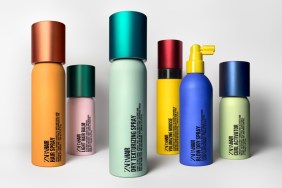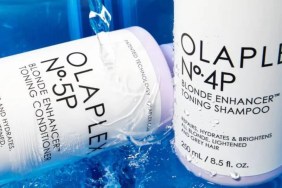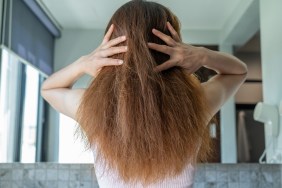Curly or coily hair is naturally dry and fragile. Yet even so, we like to dye it, fry it or constantly crazy style it all in the name of fashion. All of this manual, chemical and heat manipulation, however, can affect the health of our hair and contribute to it not looking or feeling its optimal best. Hair damage can result in the hair shaft, cuticle or cortex become frayed and cracked, unable to return to its original, healthy state without some additional help.
Though it may not be possible to miraculously repair very damaged hair without cutting the damaged areas off, there are things we can do to manage and improve its condition. “Yes, you can avoid chopping it off if the damage is not that bad,” says Kelly Foreman, CEO and founder of MopTop, Inc. “There are products and techniques out there that can temporarily improve the condition of your hair to make it look and feel healthier as well as prevent future damage.”
Here, we explore 11 strategies to minimize and manage the damage to your dry, brittle curls, so that they’re unbelievably soft once again.
Deep Conditioning Is a Must
Deep conditioners are vital in the process of restoring health and manageability to rough, brittle hair. “Dry, highly textured hair is often tangled and delicate. Moisturization is necessary to soften brittle ends and obtain soft, touchable curls,” says Miko Branch, CEO of Miss Jessie’s.
Protein Treatments Help
Protein treatments are a great way to reinforce the hair shaft and harden the cuticle layer, placing a barrier around the follicle, which protects it from further damage. Hydrolyzed proteins used in most protein treatments temporarily mend your hair by filling gaps in the cuticle, allowing your hair to better retain moisture and giving it more sheen and strength. It also revitalizes your curls by restructuring some of the bonds that make your hair curly.
There are several types of protein conditioner treatments; reconstructors, deep penetrating treatments, protein packs and light protein treatments. Reconstructors work wonders on severely damaged hair. Moderately damaged hair benefits from deep penetrating protein treatments, while slightly damaged strands can be enriched with protein packs or light protein treatments. Proceed with caution, however, since utilizing too much protein too often can cause brittleness and breakage.
Wash with a Gentle Cleanser
Sulfate shampoos strip the hair of its natural oils. Look for sulfate-free cleansing washes or conditioning creams instead. These mild, suds-free poos clean your mane, while moisturizing it at the same time.
Mother Nature Knows Best
Foreman raves about the benefits of aloe, sea botanicals and honey on parched curls. “Aloe is the oldest, most moisturizing natural ingredient; sea botanicals coat the hair shaft, adding sheen without crazy buildup; honey moisturizes inside the hair shaft and even helps to keep your hair cleaner longer.” Oils also rank high on her list. “Mongongo is the pack leader combined with abyssinian oil, they are so chock-full of vitamin E that they feed the hair. Coconut oil is positively charged where hair is negatively charged, making for a perfect balance.”
Branch, on the other hand, loves using shea butter and extra virgin olive oil to combat dryness. “Extra virgin olive oil has high levels of monounsaturated fatty acids and vitamin E. It is very emollient, and its lightweight consistency makes it easy to penetrate the hair shaft for ample moisturizing ability. It provides a more sleek, smooth and healthy appearance, and as an antioxidant, it is critical for hair growth.”
Chemicals Are Not Your Friend
Chemical processes, such as color, bleach, straighteners or texturizers can be damaging to your mane. So if you decide to do one of them, minimize the frequency of these harsh treatments and moisturize your hair as often as possible.
Limit Heat
Heat is also damaging to your hair. It can burn curly hair, leaving it lifeless, and alter the texture of curls, creating damaged, straight ends. “Remember, you fry french fries at 350 Fahrenheit and most flat irons get to 450 Fahrenheit. Healthy, undamaged hair burns at about 451 Fahrenheit — that’s why no one makes a hotter flat iron,” says Foreman. “And then since heat damage is cumulative, the temperature at which your hair will burn decreases as heat damage increases.” To minimize damage, she recommends purchasing a good quality flat iron that has an adjustable temperature setting. Next, figure out the right temperature for your hair. Start at a low temperature and increase by increments of 10 degrees until you find the right setting for your tresses.
Silicones Are Bad for Your Hair…
Silicones, aka ‘cones, can build up on the hair shaft, effectively laminating strands so that moisture cannot penetrate them. This causes hair to become dry, delicate and inelastic, leading to breakage. “Also, silicones puddle around the hair shaft and build up along with your natural sebum becoming harder, causing your hair to grow in thinner, finer and more fragile,” adds Foreman.
…Except When You’re Using Heat
Because silicones are a reliable sealant and are heat resistant up to 500 Fahrenheit and your flat iron or curling iron heat up to 450 Fahrenheit, the only time you should employ ‘cones is as a heat protectant to buffer the damage caused by these hot tools. Nevertheless, limit your usage and don’t forget to clarify your hair with an apple cider vinegar rinse from time to time to get rid of any buildup.
Invest in Satin
“The friction one may experience with a cotton or wool-blend fabric dries out hair and causes frizz and breakage. Sleeping with a satin scarf, bonnet or pillowcase, however, is excellent for highly textured hair because it minimizes friction caused while tossing and turning in one’s sleep, leading to less tangling, dryness and static,” says Branch.
Handle with Care
Dry, fragile curls are susceptible to breakage as you handle your tresses. Branch suggests detangling hair while wet with a wide-tooth comb and deep moisturizing conditioner, from bottom to top, to minimize breakage.
Sometimes There’s No Other Choice
And for hair that is severely damaged, the only way to rescue it is to snip off the damaged bits. Sorry, but sometimes there is no other way around it. If you don’t cut those ends off, the hair that is extremely brittle or split will snap off causing more damage.








